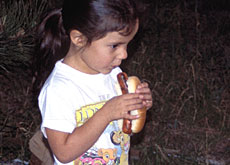Swiss clergyman studies religious life of the Sioux

Pastor Helmut Kaiser is back at his Bernese Oberland parish after studying the cultural traditions of Sioux Indians in South Dakota.
Kaiser spent two months staying near a reservation with a population of 35,000 where, at first, he was given a mixed reception.
“I stayed in a nearby cultural exchange institution,” he told swissinfo, “and was given a friendly welcome by the people there. But to begin with the inhabitants of the reservation were unhappy when I told them I was a pastor.
“They told me of their bad experiences with the church and were strongly critical of Christian belief saying ‘the Bible killed us’. But when I said ‘I don’t want to convert you’, they accepted me.”
Kaiser explained to them that he was there rather to learn about their religious traditions and way of life.
Respect for nature
Fundamental to Sioux traditions, he says, is a respect for nature and living in harmony with it. “They have one main God, but many Gods of ‘light’ and subordinate Gods. There are several Gods for different things, and you could say that there’s no distinction between God and reality.”
As for the living conditions of the people he met, Kaiser says these are generally hard: “Unemployment in the reservation is about 85 per cent. Life expectancy is 55 for men and 60 for woman, so much lower than the American average of 75 and 80.”
In the relatively short time he was with them, Kaiser learned much about the Sioux people and their traditions. He also had first hand experience of their uncanny powers of perception.
“Late one evening we were sitting outside a house with an Indian couple. Suddenly, the man and the woman said simultaneously that something had happened. The rest of us heard nothing. An hour later, a police car and ambulance arrived. There had been an accident some distance away. The Sioux couple heard it but we didn’t.”
In at least one respect, Kaiser has been delighted to do something to help one of the people he came across in South Dakota. He had met a 40-year-old woman who was in severe pain and in urgent need of surgery which she couldn’t possibly afford.
So he began a fund-raising campaign on his return to Switzerland, which in a short time raised SFr12,000 ($8,000). The operation can now go ahead.
swissinfo, Richard Dawson
The people of the Great Sioux Nation prefer to be called Dakota, Lakota, or Nakota, according to their language group.
A rich oral tradition relates their values, culture, and spirituality of the Great Sioux Nation.
The stars, known as the Great Spirit’s holy breath, the sun and the earth figure prominently in this tradition.
Today, as yesterday, the people of the Great Sioux Nation seek to live in harmony with the universe.
Past leaders include Crazy Horse and Sitting Bull.

In compliance with the JTI standards
More: SWI swissinfo.ch certified by the Journalism Trust Initiative
You can find an overview of ongoing debates with our journalists here. Please join us!
If you want to start a conversation about a topic raised in this article or want to report factual errors, email us at english@swissinfo.ch.